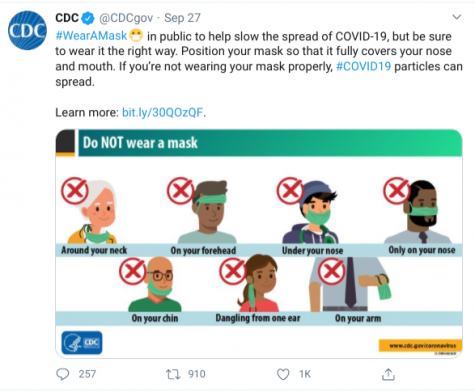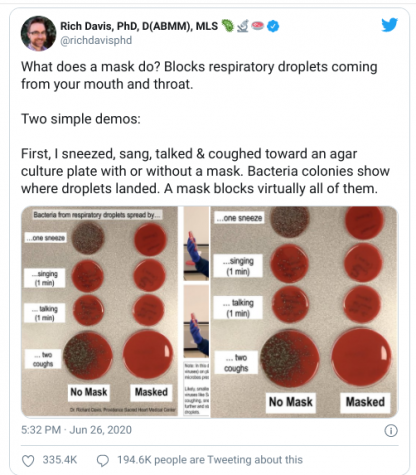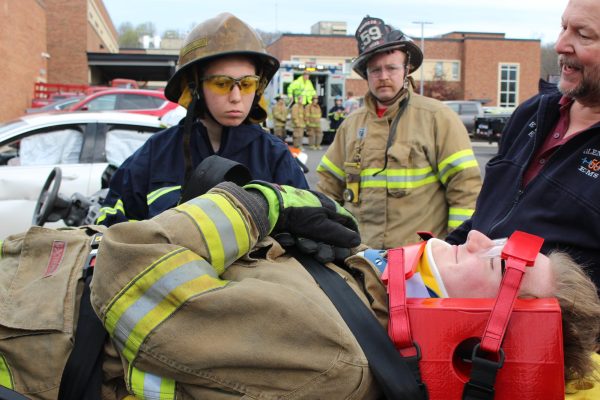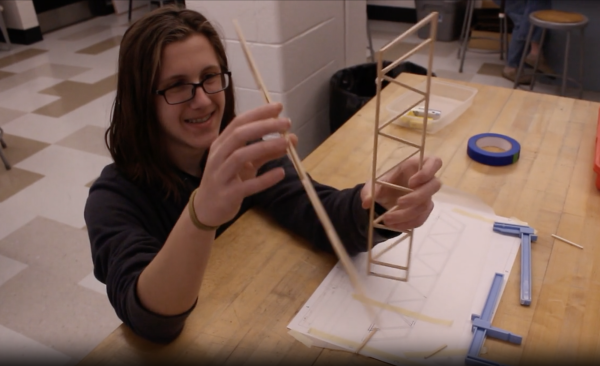The Importance of Wearing a Mask Properly
Across the globe, people are refusing to wear masks correctly, putting hundreds of lives at risk.
Since COVID-19 was declared a pandemic in March, masks have become the new normal, but are ineffective unless worn properly.
The Center for Disease Control and Prevention has been urging the public to wear masks since COVID-19 began to affect citizens of the United States.

“Your mask should cover your nose AND mouth to help protect others and slow the spread of COVID-19,” said the CDC in a recent Tweet.
Quite a few students find the concept of mask-wearing as rather useless against the pandemic because face coverings are not taken seriously.
Sophomore KC O’Neill agrees that masks offer little protection within the school environment.
“I think masks aren’t effective because most people don’t wear them correctly,” said O’Neill “Certain types of masks can be effective, but other masks like cloth masks and face shields aren’t the most protective.”
Cloth masks have been statistically proven to be far less effective in protecting against COVID-19.
Mary Van Beusekom, a reporter from the Center for Infectious Disease Research and Policy through the University of Minnesota, acknowledges how difficult it can be to predict the effectiveness of a mask.
“…Homemade fabric masks may capture large respiratory droplets, but there is no evidence they impede the transmission of aerosols implicated in the spread of COVID-19…” said Van Beusekom. “…aerosols likely play an important role in coronavirus transmission, cloth masks will do little, if anything, to limit the spread of the disease.”
In an interview hosted by Insider, microbiologist Rich Davis further demonstrates to critics of CDC guidelines that correctly worn masks are beyond effective when it comes to inhibiting the exposure of others to respiratory droplets.

Although it is true that Davis’s experiment relies on bacteria instead of viruses, he explains that the methods of transmission are the same.
“Even though individual viruses are many magnitudes smaller than individual bacteria, large droplets are what most respiratory viruses are contained in and these are blocked by masks,” said Davis.
Johns Hopkins Medicine agrees that “just wearing masks” is not enough, and it is necessary to understand the proper mask-wearing technique to keep you and others as safe as possible.
“…You might find people wearing masks in a variety of different styles: dangling from one ear, pulled down below the nose, or resting below the chin,” said Johns Hopkins. “These common mistakes decrease the effectiveness of masking and increase the wearer’s risk of catching and spreading the disease.”
Elizabeth McGraw, a doctor from Penn State University, explains that masks must cover the nose because of how COVID-19 is contracted.
“When we sample people to see if they are positive [for COVID-19], one of the sites that we sample is the nasal cavity,” said McGraw. “That really gives evidence that the virus is present in those nasal passages.”

Robert Redfield, the director of the CDC, responds to mask controversy through the American Medical Association.
“Masking is not a political issue,” said Redfield. “It is a public health issue. It really is a personal responsibility for all of us.”
In order to flatten the climbing case rate of COVID-19, it is imperative that each and every citizen wears a face covering in public whenever possible.
“If we really embrace masking, if we really embrace the social distancing and hand washing, we could bring this outbreak to its knees,” said Redfield.

Senior Alexa Viands is the Editor-in-Chief for the Courier and is a third-year staff member. Lex is looking forward to writing many different styles of...







